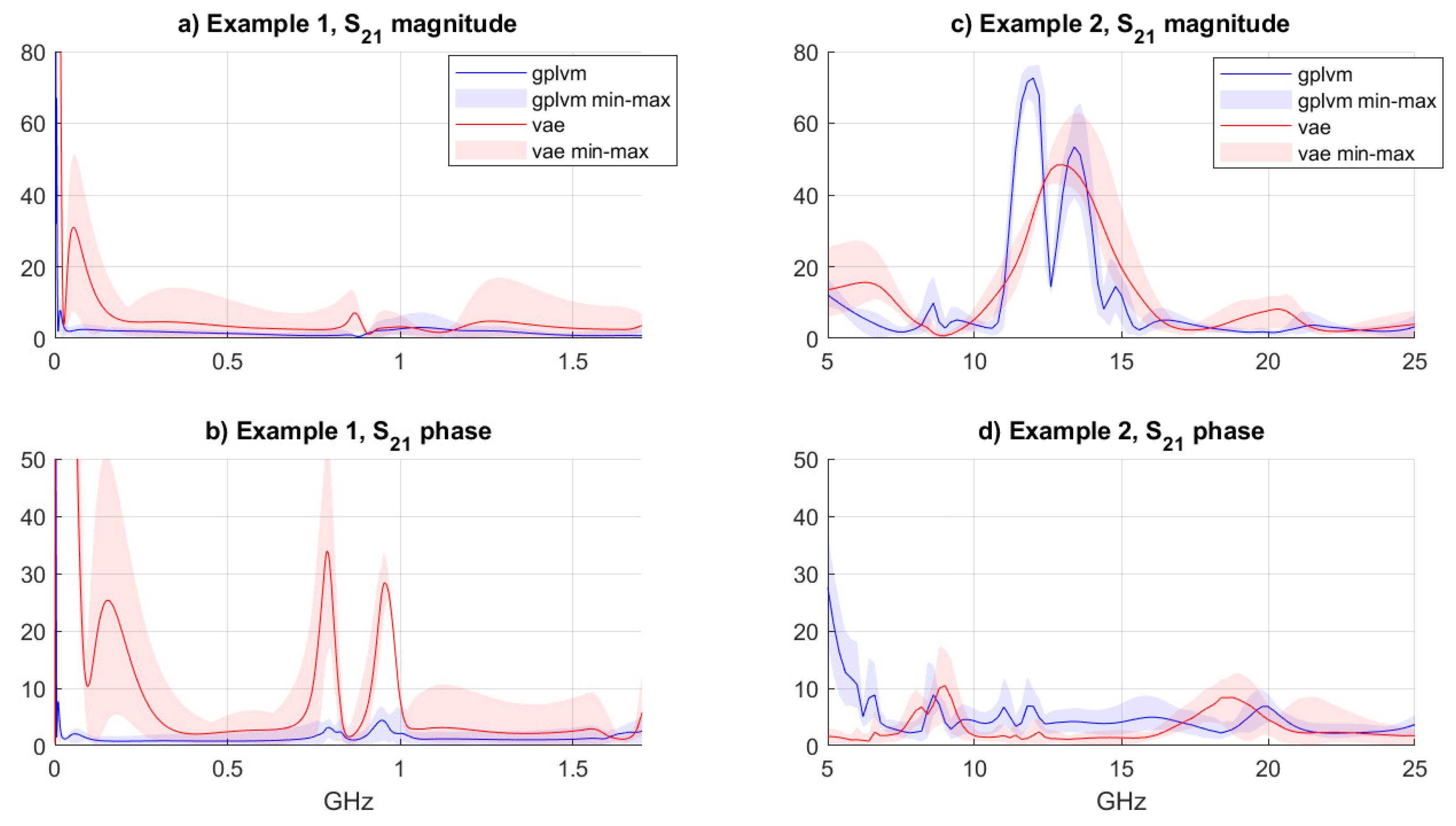Evaluation of Generative Modeling Techniques for Frequency Responses †
Abstract
:1. Introduction
2. Methodology
2.1. Vector Fitting
2.2. Gaussian Process Latent Variable Model
2.3. Variational Autoencoder
2.4. Similarity Metric
3. Results and Discussion
4. Conclusions
Funding
References
- Ye, Y.; Spina, D.; Manfredi, P.; Ginste, D.V.; Dhaene, T. A Comprehensive and Modular Stochastic Modeling Framework for the Variability-Aware Assessment of Signal Integrity in High-Speed Links. IEEE Trans. Electromagn. Compat. 2018, 60, 459–467. [Google Scholar] [CrossRef]
- Fei, Z.; Huang, Y.; Zhou, J.; Xu, Q. Uncertainty Quantification of Crosstalk Using Stochastic Reduced Order Models. IEEE Trans. Electromagn. Compat. 2017, 59, 228–239. [Google Scholar] [CrossRef]
- De Ridder, S.; Deschrijver, D.; Manfredi, P.; Dhaene, T.; Vande Ginste, D. Generation of Stochastic Interconnect Responses via Gaussian Process Latent Variable Models. IEEE Trans. Electromagn. Compat. 2018, 61, 582–585. [Google Scholar] [CrossRef]
- Ma, X.; Raginsky, M.; Cangellaris, A.C. A Machine Learning Methodology for Inferring Network S-parameters in the Presence of Variability. In Proceedings of the 2018 IEEE 22nd Workshop on Signal and Power Integrity (SPI), Brest, France, 22–25 May 2018. [Google Scholar]
- Gustavsen, B.; Semlyen, A. Rational approximation of frequency domain responses by vector fitting. IEEE Trans. Power Deliv. 1999, 14, 1052–1061. [Google Scholar] [CrossRef]
- Titsias, M.; Lawrence, N.D. Bayesian Gaussian process latent variable model. In Proceedings of the Thirteenth International Conference on Artificial Intelligence and Statistics, Sardinia, Italy, 13–15 May 2010; pp. 844–851. [Google Scholar]
- Kingma, D.P.; Welling, M. Auto-Encoding Variational Bayes. arXiv 2013, arXiv:1312.6114v10. [Google Scholar]
- Anderson, T.W. On the distribution of the two-sample Cramer-von Mises criterion. Ann. Math. Stat. 1962, 33, 1148–1159. [Google Scholar] [CrossRef]
- De Ridder, S.; Deschrijver, D.; Spina, D.; Vande Ginste, D.; Dhaene, T. Statistical modeling of frequency responses using linear Bayesian vector fitting. Int. J. Numer. Model. Electron. Netw. Devices Fields 2020. [Google Scholar] [CrossRef]
- Keysight EEsof EDA, Advanced Design System, 471. Update 1.0. 2018. Avaliable online: https://www.keysight.com/cn/zh/assets/7018-01027/brochures/5988-3326.pdf (accessed on 14 October 2020).




| Example 1: Pair of Couple Transmission Lines | Example 2: Folded-Stub Notch Filter | |
|---|---|---|
| Frequency range [GHz] | 0–1.8 | 5–25 |
| Frequency step [GHz] | 0.0017 | 0.2 |
| Selected ports | [1, 2] | [1,2] |
| Design parameters | substrate height and permittivity, line widths, line spacing | substrate height and permittivity, stubs spacing, stubs length |
| No. of design parameters | 5 | 4 |
| Parameters standard deviation | 10% of nom.value | 5% of nom.value |
| No. training instances | 50 | 100 |
| No. validation instances | 950 | 300 |
| Rational model order | 10 | 20 |
Publisher’s Note: MDPI stays neutral with regard to jurisdictional claims in published maps and institutional affiliations. |
© 2020 by the authors. Licensee MDPI, Basel, Switzerland. This article is an open access article distributed under the terms and conditions of the Creative Commons Attribution (CC BY) license (https://creativecommons.org/licenses/by/4.0/).
Share and Cite
Garbuglia, F.; Spina, D.; Deschrijver, D.; Dhaene, T. Evaluation of Generative Modeling Techniques for Frequency Responses. Eng. Proc. 2020, 3, 7. https://doi.org/10.3390/IEC2020-06970
Garbuglia F, Spina D, Deschrijver D, Dhaene T. Evaluation of Generative Modeling Techniques for Frequency Responses. Engineering Proceedings. 2020; 3(1):7. https://doi.org/10.3390/IEC2020-06970
Chicago/Turabian StyleGarbuglia, Federico, Domenico Spina, Dirk Deschrijver, and Tom Dhaene. 2020. "Evaluation of Generative Modeling Techniques for Frequency Responses" Engineering Proceedings 3, no. 1: 7. https://doi.org/10.3390/IEC2020-06970
APA StyleGarbuglia, F., Spina, D., Deschrijver, D., & Dhaene, T. (2020). Evaluation of Generative Modeling Techniques for Frequency Responses. Engineering Proceedings, 3(1), 7. https://doi.org/10.3390/IEC2020-06970





